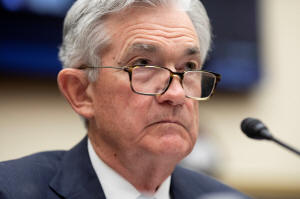Inflation-wary bond markets focused on Fed's tricky balancing act
 Send a link to a friend
Send a link to a friend
 [March 14, 2022] By
Karen Brettell [March 14, 2022] By
Karen Brettell
(Reuters) - With the Federal Reserve almost
certain to hike interest rates this week for the first time in more than
three years, investors will be focused on how it plans to curb a surge
in inflation inflamed by the Ukraine crisis without triggering a
recession.
The U.S. central bank is expected at the very least to raise borrowing
costs at each of its next three policy meetings as it scrambles to
address the fastest inflation in 40 years. Consumer prices rose 7.9% in
February on an annual basis.
But having waited until it was sure the economy and labor market had
recovered from the COVID-19 pandemic, the Fed also risks tightening
monetary policy just as growth is slowing. Western sanctions to punish
Russia for its invasion of Ukraine have sent the prices of oil and other
commodities soaring, adding to uncertainty over the trajectory of the
global economy.
"The policy path set forward is going to be one for further increases,"
said Kim Rupert, managing director of global fixed income analysis at
Action Economics, who added that Fed Chair Jerome Powell and his fellow
policymakers would likely take a cautious data-dependent approach. "They
really can't do anything else given the uncertainties from the war."
Powell's news conference after the end of the two-day policy meeting on
Wednesday will be closely watched for possible clues as to how
aggressive the Fed may be in fighting inflation and whether it will risk
a recession to dampen price pressures.

Bond markets are already betting on a possible economic contraction down
the road, with the two-year, 10-year U.S. Treasury yield curve
flattening to only 25 basis points, a much smaller gap than at the
beginning of previous Fed tightening cycles. An inversion in this part
of the yield curve is seen as a reliable indicator of a recession in one
to two years.
The Fed's benchmark overnight interest rate ahead of this week's policy
meeting was 0.08%. Fed fund futures traders are pricing in a policy rate
of 1.75% by the end of this year. [FEDWATCH]
The Fed will also on Wednesday release updated quarterly economic
projections and a "dot plot" showing policymakers' interest rate
projections. Markets expect the Fed to indicate more rate hikes this
year and possibly a higher terminal rate, the neutral interest rate seen
as consistent with full employment and stable prices.
"Our sense is that they are going to want to front-load the policy
tightening and probably go at a slower pace in 2023," said Zachary
Griffiths, a macro strategist at Wells Fargo. "It will be interesting to
see if any policymakers are starting to revise up their expectations for
the terminal rate in response to expectations that inflation will be a
fair bit higher perhaps throughout this cycle than what we saw
throughout the last economic expansion."
[to top of second column] |

Federal Reserve Chair Jerome Powell looks on as he testifies before
a U.S. House Financial Services Committee hearing on Capitol Hill in
Washington, U.S., March 2, 2022. REUTERS/Tom Brenner

The new economic projections will show if officials see a near-term easing of
price pressures and to what extent GDP growth expectations have been lowered.
BALANCE SHEET REDUCTION
The Fed also may indicate how fast and large the cuts to its $8.9 trillion
balance sheet will be when the bonds it holds start rolling off the books, which
many analysts expect to happen in May or June.
The central bank also is widely expected to announce that it has ended the
massive bond-buying program initiated in early 2020 to blunt the damage of the
pandemic. The asset purchases had dwindled since November 2021.
In January, the Fed said it did not anticipate it would sell its holdings of
Treasuries, but instead would allow them to mature without being replaced. It
may, however, sell its mortgage-backed securities, which could relieve some of
the pressure in hot housing markets.
Meanwhile, money markets will key in on whether the Fed raises the rate it pays
investors to borrow Treasuries overnight in its repurchase agreement facility by
25 basis points, or only 20 basis points, following a five-basis point increase
last June that was meant to stop short-term interest rates from falling too low.
That could impact demand for the Fed's reverse repo facility, in which investors
borrow Treasuries overnight, and which continues to see near-record daily
volumes of around $1.5 trillion, said Padhraic Garvey, regional head of research
for the Americas at ING.
A smaller rate hike for this facility could "unwind some of this excess cash
that goes back into that window on a daily basis," he said. That said, given
it's the first rate hike, the Fed may want to simplify the messaging by keeping
the 25-basis-point hikes consistent across rates and highlight that there are
more to come, he noted.
The central bank raised counterparty limits in the reverse repo facility twice
last year to address excess liquidity amid a dearth of safe, short-term
investments.
(Reporting by Karen Brettell; Editing by Alden Bentley and Paul Simao)
[© 2022 Thomson Reuters. All rights
reserved.]This material may not be published,
broadcast, rewritten or redistributed.
Thompson Reuters is solely responsible for this content.
 |